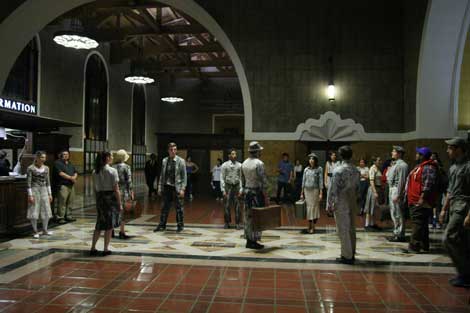There’s something suggestive of time travel as well as terrestrial travel in The Industry and LA Dance Project’s production of Christopher Cerrone’s Invisible Cities—adapted from Italo Calvino’s poetic masterpiece—as true to the spirit of Calvino’s work as almost every aspect of the production.
That the production captured so many of the novel’s myriad facets—utilizing everything from the incomparable setting of Union Station, to the dancers and their complex choreography of dance, step, march, parade, gesture, and the costumes, variously neutral and elaborate both in pattern, palette and design—was uncanny and astonishing.
The book is structured as a series of narratives and dreamlike excursions describing fantastical cityscapes and recounting snippets of alternately eccentric and mundane urban life, all bracketed within pairs of dialogues between Kublai Khan and his guest and roving ambassador, Marco Polo.
Much was made of the notion of a theatrical production geared to the iPod generation and/or an avant-garde audience steeped in performance work frequently accompanied by sophisticated audio or multi-channel digital media. But what was most notable about the Sennheiser headsets created for the production was the extent to which the audience was able (with a few exceptions) to all but forget they were wearing them. Sennheiser’s contribution was not merely to enhance (or isolate) but to seamlessly facilitate the layering of an additional dimension to the experience.
The dialogues begin with the disembodied voice of a narrator who disappears as quickly as he appeared. We, the audience—unresolved and slightly unmoored—effectively perform this framing function, each silently listening to the voice channeled into our headsets: “There is a sense of emptiness that comes over us…” We are solitary, invisible witnesses to a passing moment, our civilization reduced to a “tracery.” The principals, in turn, seem to emerge, literally, in our traces. We can’t immediately identify Polo (Ashley Faatoalia) or even the Khan (Cedric Berry) until a moment in a courtyard when it becomes clear that the figure in a wheelchair and the burly but otherwise anonymous-looking man in red fleece and plaid carrying a backpack are in fact the Khan and Polo.
Polo and the Khan echo and parallel more than respond to each other in a metaphorical dialogue of repletion and depletion. Cerrone expresses the parallel tensions with a rolling motive of oscillating thirds and fourths within a minor seventh chord that underscores many of the airs and recitative lines through the opera. They’re each recounting journeys, each viewed as a long recession toward a vanishing point.
Audience members were encouraged to wander through the “historic” parts of the Station. The nonlinear narrative unfolds in poetic cadences, with bits of action or situations crystallizing or focalizing like pieces in a kaleidoscope falling into a specific configuration—except that here the mirrors are irregular and distorting, with focus and light source variably lengthening and thrown up close, maybe even brushing right past us. We, the audience are the mirrors—each with its own irregularities and set at its own eccentric angle. We also become part of the scenery and the choreography—a corps de ballet to the performers and dancers. We are each, in a sense, the hypothetical traveler, the “foreigner” of Polo’s narratives (and each of us reflections of Polo himself).
Cerrone works within a limited, but richly textured (considering the orchestra’s 11-piece size) musical palette, variously heightening and flattening tension through percussive attack, tremolo, resonance and decay. The formal relationship between Khan and Polo is defined in this tension. The spare musical lines, sometimes as few as three or four notes, have the quality of antiphonal chant, more than the conventional aria or recitative. But the style here is really modal rather than minimalist.
The opera carried us from the old (Fred Harvey) Restaurant space to the waiting room, where “travelers” moved purposefully among actual travelers; to courtyards where dancers disported among box hedges; to the newsstand concession where the sopranos in blue coveralls were mopping the floors; to the watery space evoked among the trees of another courtyard by a quartet of masked couples in evening dress (where we were clearly in Polo’s remembered Venice); down the transept between the waiting room, restaurant and main entrance—into “Adelma,” “where the dead outnumber the living;” and ultimately, in the trail of careering, careening, convulsing dancers, past the information desk and into the ticketing concourse, where the dancers moved among the ticket stations as if among crenellated city walls—their classical positions underscoring the dual sense of transit and the eternal.
There, in the symbolic heart of the aspirational city—reservoir of devices, intersecting loci of dreams and culture —Cerrone brought his opera to its final ‘decay,’ an evocation of the silence (or just a sigh), the ‘tracery’ of a fading civilization. Invisible Cities demarcates a specific moment in post-imperial America and a civilization hurtling towards self-
destruction. It is also one of the most original theatrical productions and possibly the most original opera of the century to date.
The Industry and LA Dance Project’s production of
Christopher Cerrone’s Invisible Cities
Photos by Dana Ross


